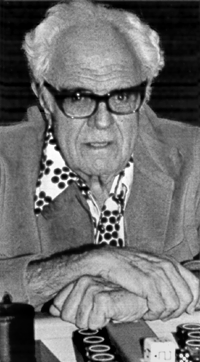|
| Etiquette |
Backgammon Etiquette
Las Vegas Backgammon Magazine, June 1980
"Good etiquette makes for good backgammon and good fun. Poor etiquette leads to arguments, bad backgammon, and no fun at all."
- Make all plays very carefully. Use just one hand to move the men. Leave your dice strictly alone until all moves have been made. Don't move two men at the same time.
- Play ends when you start to pick up your dice. Don't touch the dice until your move is completed or you might be forbidden to complete the move.

- In some complicated positions you may actually move your men with the intention of studying the position. In such cases your opponent should not roll until you start to pick up your dice, but good etiquette also demands that when you make a tentative move you announce that you are thinking it over. If you announce in advance that this move is tentative, your opponent will concentrate on the original position and there will be far less risk of argument.
- A moved man should be carefully placed squarely on the point in order to avoid later arguments as to his proper location.
- Shake the dice well on each roll. Hold your hand over the mouth of the dice cup while shaking, but make sure to remove it before the actual roll.
- It doesn't do a bit of good to bang down your dice cup or throw the dice. The best you can do about your own bad dice is to shake them hard and extra long. It doesn't really do any good, but it isn't bad manners and it does give you a chance to blow off steam and cool down.
- Conversation should be kept to a minimum, as it may upset an opponent. Kibitzer friends watching the game should not make comments.
- Backgammon is most enjoyable when played quickly. A game should last between six and eight minutes.
- When bearing off, do not stack your men in one tall pile. Men that accidentally fall back into play cause arguments.
- Do not rattle your dice when it's not your turn to play.
- Do not slam the men onto the playing field while making a move.
- Slide the doubling cube to your opponent. Don't flip, roll, or toss it to him.
- Keep dual scores and compare them often.
- Keep elbows, drinks, ashtrays, and other debris well away from the playing area.
- Breaks should be taken at the end of the game.
- Dice changes should be made at the end of the game. A player should ask for (not grab) the opponent's dice and shake all four dice in one cup. First choice goes to the player not asking for the dice change.
- All disputes over direction and color should be amicably resolved by a roll of the dice.
- Cynicism, ridicule, and vulgarities are not part of good backgammon.
- Good etiquette and common sense dictate that you don't blow smoke into your opponent's face, engage in overt displays of affection, or perform grooming activities during play.
- Good sportsmanship includes settling your obligations promptly.